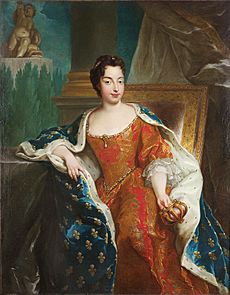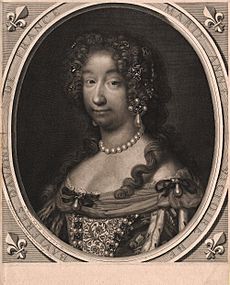Maria Anna Victoria of Bavaria facts for kids
Quick facts for kids Maria Anna Victoria of Bavaria |
|||||
|---|---|---|---|---|---|
| Dauphine of France | |||||

Posthumous portrait holding the coronet of a Dauphine, François de Troy
|
|||||
| Born | 28 November 1660 Munich, Bavaria |
||||
| Died | 20 April 1690 (aged 29) Palace of Versailles, France |
||||
| Burial | Royal Basilica of Saint Denis | ||||
| Spouse | |||||
| Issue | |||||
|
|||||
| House | Wittelsbach | ||||
| Father | Ferdinand Maria, Elector of Bavaria | ||||
| Mother | Henriette Adelaide of Savoy | ||||
| Religion | Roman Catholicism | ||||
Maria Anna Christine Victoria of Bavaria (French: Marie Anne Victoire; born November 28, 1660 – died April 20, 1690) was a Dauphine of France. This means she was the wife of the heir to the French throne. She married Louis, Grand Dauphin, who was the son of King Louis XIV.
People at the French court called her la Grande Dauphine. She was known for being quite private and often unwell. Maria Anna is an important ancestor because all the kings and queens of Spain after her son Philip V are related to her.
Contents
Life of Maria Anna
Early Years in Bavaria
Maria Anna was the oldest daughter of Ferdinand Maria, Elector of Bavaria. Her mother was Princess Henriette Adelaide of Savoy. She was born in Munich, the capital city of Bavaria.
When she was only eight years old, in 1668, she was promised in marriage to the French Dauphin. This meant she would one day become the future Queen of France. She was carefully educated for this important role. Besides her native German, she learned to speak French, Italian, and Latin. She was said to be excited about becoming the Dauphine of France.
Maria Anna was very close to her mother, who passed away in 1676. Her siblings included Violante of Bavaria and Maximilian II Emanuel, who later became the Elector of Bavaria.
Becoming Dauphine of France
Maria Anna married the Dauphin in a special ceremony in Munich on January 28, 1680. This was a "proxy" marriage, meaning someone stood in for the Dauphin. The couple met for the first time later, on March 7, 1680, in Châlons-sur-Marne, France. She was the first Dauphine of France since Mary, Queen of Scots married Francis II of France in 1558.
When she married, Maria Anna gained the title of a Fille de France (Daughter of France). This gave her the special title "Royal Highness" and people addressed her as Madame la Dauphine.
When Maria Anna first arrived in France, she made a good impression with her excellent French. In Strasbourg, someone tried to greet her in German. But she quickly replied, "Gentlemen, I speak French!" However, some people thought her appearance was not very pleasing. Others said that even if she wasn't beautiful, she had a charming personality.
After her marriage, Maria Anna was the second most important woman at the French court. The most important was her mother-in-law, Queen Maria Theresa, who was King Louis XIV's wife.
When the Queen died in July 1683, Maria Anna became the most important lady at court. She was given the Queen's old apartments. King Louis XIV expected her to take on the duties of the first lady. However, her poor health made it very hard for her to do so. The King did not understand her health problems and wrongly thought she was just pretending to be sick.
Her husband, the Dauphin, had other romantic interests. Maria Anna often lived a quiet life in her own rooms. She would speak in German with her close friend and helper, Barbara Bessola. Her husband could not understand German. She was also close to Elizabeth Charlotte of the Palatinate, who was also German and married to the King's younger brother, Philippe. Maria Anna was said to feel sad living in a court where beauty was so highly valued, as she did not consider herself beautiful.
Some letters from Elizabeth Charlotte suggest that Madame de Maintenon, a powerful woman at court, did not want the Dauphine to become influential. It was claimed that Madame de Maintenon paid Barbara Bessola to keep Maria Anna away from court life. At the same time, Maria Anna's lady-in-waiting, Marguerite de Montchevreuil, supposedly encouraged the Dauphin's interest in other women.
Passing Away
Maria Anna passed away in 1690. After her death, doctors examined her body. They found many internal health problems. This showed that her complaints about being chronically and severely ill were true.
Maria Anna was buried in the Royal Basilica of Saint Denis, a traditional burial place for French royalty.
Her Children
Maria Anna and the Grand Dauphin had three sons:
- Louis de France (born August 16, 1682 – died February 18, 1712). He was the Duke of Burgundy and later became the Dauphin of France. He married his cousin Princess Maria Adelaide of Savoy. They were the parents of Louis XV of France.
- Philippe de France (born December 19, 1683 – died July 9, 1746). He was the Duke of Anjou and later became the King of Spain. He married Princess Maria Luisa Gabriella of Savoy and had children. He married again to Elisabeth Farnese and had more children. He was the first Bourbon king of Spain. All later Spanish monarchs are his descendants.
- Charles de France (born July 31, 1686 – died May 5, 1714). He was the Duke of Berry. He married his cousin Marie Louise Élisabeth d'Orléans. They had children, but none of them lived past one year old.
See also
 In Spanish: María Ana Victoria de Baviera para niños
In Spanish: María Ana Victoria de Baviera para niños


